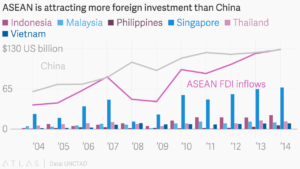As an important member of ASEAN and an important financial, trade, service, and shipping center in the region, Singapore has played a key role in the construction of the “Belt and Road Initiative.” While deepening the level of interconnection and interoperability with China and bilateral relations, Singapore has also become a deeper focus for Chinese companies as an important bridge to expand the Southeast Asian market.
Overview of Economic and Investment Environment in Singapore
Singapore is located in the heart of ASEAN, adjacent to major Southeast Asian countries such as Indonesia and Malaysia. It enjoys a superior geographic location and significant geographical advantages. It not only links all ASEAN countries, but also has close commerce and trade with China, Japan, South Korea, the United States and other major Asian and Western countries. An important hub and commercial center that connects the entire Southeast Asia and Asia Pacific markets. Singapore has a well-developed infrastructure, a developed economy, and a stable society. It also has a well-developed business network, a sound legal environment, and a clean and efficient government system. As a result, the global business environment, economic freedom, and national innovation capabilities are related to business investment. All of the core indicators are ranked high.
However, due to the limited land area and the scarcity of natural resources, Singapore is a typical export-driven economy and highly dependent on the international market2. In recent years, with the steady progress of the “One Belt and One Road” initiative, Chinese companies have continuously increased their investment in Singapore and expanded their investments. At present, Singapore is mainly engaged in professional services such as finance and shipping, and electronics, petroleum and petrochemical. In the coming years, the Singapore government plans to vigorously develop innovative industries such as digital industries. Singapore is expected to exert its advantages and assist Chinese companies in further expanding their technological innovation in Southeast Asia. The market has become a pilot area of the “Belt and Road” technology innovation industry.

Singapore’s tax incentives for attracting foreign investment
The Singapore government provides extensive tax incentive support to attract foreign investment. Among them, the tax incentive measures focus on promoting the consolidation of a large number of high-value-added businesses in Singapore and enhancing their own level of innovation and professional skills. In order to improve Singapore’s local business environment and make it more attractive, tax incentives as a fiscal policy tool can effectively highlight Singapore’s status as a major global business and investment hub.
Singapore’s Role and Prospects under the Belt and Road Initiative
China and Singapore are mutually important economic and trade cooperation partners. In recent years, bilateral economic and trade cooperation has developed rapidly and the cooperation has become broader and deeper. Chinese investors have always regarded Singapore as one of the important overseas investment destinations. In 2017, the rapid growth of Chinese companies’ M&A activity in Singapore made Singapore the largest destination for 2017 China’s overseas M&A, including transportation, technology, telecommunications, and life. The science industry is most favored by Chinese investors.
Invest in potential industry
Singapore is an important country along the “Maritime Silk Road” and can play a key role in the “One Belt and One Road” as an important strategic fulcrum. At present, Singapore companies and Chinese companies are actively cooperating to expand projects along the way and explore investment opportunities. The two sides are involved in a number of industries including energy, infrastructure, shipping, logistics, finance, real estate development and new media.
Financial service
In order to further enhance the attractiveness of the investment and make Singapore a world-class financial center, the Monetary Authority of Singapore has relaxed its control over Singapore’s domestic banking industry and insurance industry in 2017. For the first time, it allowed foreign investors to acquire Singapore’s non-banking financial companies and will supervise them. Turn to risk-based control, relax restrictions on fund management companies managing domestic funds, develop debt markets and improve corporate governance. In order to support the “One Belt, One Road” initiative, at the end of 2017, the “Singaporean Belt and Road Insurance Consortium” was established by the Singapore Branch of China Reinsurance (Group) Co., Ltd., a consortium that brings together local insurance companies and reinsurance companies. , Brokerage company will take the lead in the field of engineering insurance, cargo and liability insurance to provide “Band and Road” related projects with quality underwriting capabilities, professional insurance protection and risk management services, and provide “one-stop” solutions.
Emerging technology industry
High-end human resources platform
The advantage of having many talents is pushing Chinese companies to use Singapore as an ideal bridge for investing in markets such as Southeast Asia. The labor force in Singapore is not only highly educated, but about 60% of the workforce is proficient in Chinese 10, and more than 40% of the workforce can speak two languages and understand Chinese. The Singapore government has also been committed to working with all parties to train young people who know China and are familiar with Asia through various training programs and incentives.



